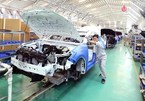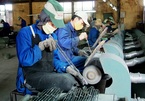 |
The ministry has also proposed a VND100-trillion credit package which will develop the supporting industries, mainly for auto manufacturing. The fresh move brings hope for the automobile industry but also sparks doubt over the result of the huge funds for the project.
Over the past dozen years, many plans have been proposed to help the automobile industry increase the local content but the situation has barely improved. The local content is still several percentage points, far below the 40% target, and imported cars have made more inroad into the local market, as many foreign-invested auto assemblers have closed down their plants and switched to auto trading.
The author thinks that the automobile industry development plans have failed because management agencies have focused only on the financial aspect with tariffs and incentives, and the big market potential, which has yet to be materialized. In mathematical terms, finance is only the necessary, not the sufficient condition. The sufficient condition is a strong internal force.
An experience to learn is the success of Morocco’s automobile industry. From a poor start, it has developed into a strong industry, turning out 335,000 cars in 2017 with a local content of 65%. The rate is expected to reach 85% over the next two years, turning Morocco into one of the top five auto exporters to Europe. Negotiations with Volkswagen, Ford and Fiat over investment in large-scale auto manufacturing projects are underway.
One important factor for the success is reflected through the following statement by Carlos Tavares, CEO of PSA. “World-class infrastructure, especially in the import-export sector, and the good training of auto engineers and experts are the decisive factor for PSA Peugeot-Citroen to choose Morocco for investment,” he said.
Earlier, Renault has cooperated with Morocco in a plan for logistics infrastructure development and hi-tech manpower training for the auto industry. The cooperation has led to the decision to build a large Renault auto plant in Tanger Port, marking the start for strong development of Morocco’s auto industry. After five years of operations, it rolled out the one millionth car in July 10, 2017.
Strong internal force
The automobile is a heavy, complex industry. Some essential factors for its success are large scale, high level of industrialization, and strong finance, technological capacity and management expertise. Therefore, countries with a young auto industry need government support for a strong internal force to survive a highly competitive market. The author would suggest that one of the targets of the proposed huge credit package should be to increase the internal force of the auto industry, that is to train technological experts and managers for work in auto enterprises.
In particular, efforts should be made to:
- Increase support for cooperation between universities and vocational schools and auto enterprises, increase apprenticeship at workshops, support learning-while-doing programs to meet the industry demand, increase teaching by experts from auto enterprises, and promote continuing training and expert training.
- Increase support for joint research programs between universities and the auto industry because innovations are crucial in a competitive market.
- Encourage and help auto enterprises carry out training programs to improve total quality, and thereby to develop a quality culture. Quality is the key to success in the competitive auto market. Japanese automakers have conquered the global market thanks to their “total quality management.”
These efforts would help build a strong internal force to prepare for the future and do away with the loose, sub-standard management style.
The ministry has also proposed a VND100-trillion credit package which will develop the supporting industries, mainly for auto manufacturing. The fresh move brings hope for the automobile industry but also sparks doubt over the result of the huge funds for the project.
Over the past dozen years, many plans have been proposed to help the automobile industry increase the local content but the situation has barely improved. The local content is still several percentage points, far below the 40% target, and imported cars have made more inroad into the local market, as many foreign-invested auto assemblers have closed down their plants and switched to auto trading.
The author thinks that the automobile industry development plans have failed because management agencies have focused only on the financial aspect with tariffs and incentives, and the big market potential, which has yet to be materialized. In mathematical terms, finance is only the necessary, not the sufficient condition. The sufficient condition is a strong internal force.
An experience to learn is the success of Morocco’s automobile industry. From a poor start, it has developed into a strong industry, turning out 335,000 cars in 2017 with a local content of 65%. The rate is expected to reach 85% over the next two years, turning Morocco into one of the top five auto exporters to Europe.
Negotiations with Volkswagen, Ford and Fiat over investment in large-scale auto manufacturing projects are underway. One important factor for the success is reflected through the following statement by Carlos Tavares, CEO of PSA. “World-class infrastructure, especially in the import-export sector, and the good training of auto engineers and experts are the decisive factor for PSA Peugeot-Citroen to choose Morocco for investment,” he said.
Earlier, Renault has cooperated with Morocco in a plan for logistics infrastructure development and hi-tech manpower training for the auto industry. The cooperation has led to the decision to build a large Renault auto plant in Tanger Port, marking the start for strong development of Morocco’s auto industry. After five years of operations, it rolled out the one millionth car in July 10, 2017.
The automobile is a heavy, complex industry. Some essential factors for its success are large scale, high level of industrialization, and strong finance, technological capacity and management expertise.
Therefore, countries with a young auto industry need government support for a strong internal force to survive a highly competitive market. The author would suggest that one of the targets of the proposed huge credit package should be to increase the internal force of the auto industry, that is to train technological experts and managers for work in auto enterprises.
In particular, efforts should be made to:
- Increase support for cooperation between universities and vocational schools and auto enterprises, increase apprenticeship at workshops, support learning-while-doing programs to meet the industry demand, increase teaching by experts from auto enterprises, and promote continuing training and expert training.
- Increase support for joint research programs between universities and the auto industry because innovations are crucial in a competitive market.
- Encourage and help auto enterprises carry out training programs to improve total quality, and thereby to develop a quality culture. Quality is the key to success in the competitive auto market. Japanese automakers have conquered the global market thanks to their “total quality management.”
These efforts would help build a strong internal force to prepare for the future and do away with the loose, sub-standard management style. SGT

Vietnam to loosen conditions for auto imports
The Vietnamese Government will soon issue a revision to Decree 116/2017 on the conditions for production, assembly, import and business of automobile warranty and maintenance services.

Vietnam to spend $4.3 billion to develop automobile industry
Experts think the plan to spend $4.3 billion to develop the automobile industry will be in vain.
 The Ministry of Industry and Trade is expected to submit to the Government an automobile industry development plan with solutions to supporting auto manufacturing projects in Vietnam.
The Ministry of Industry and Trade is expected to submit to the Government an automobile industry development plan with solutions to supporting auto manufacturing projects in Vietnam.